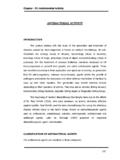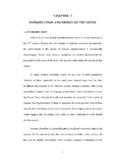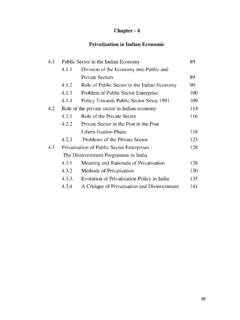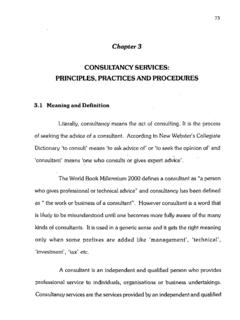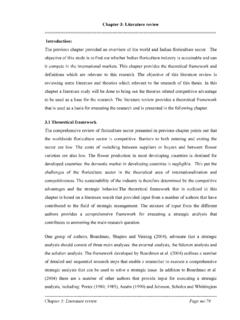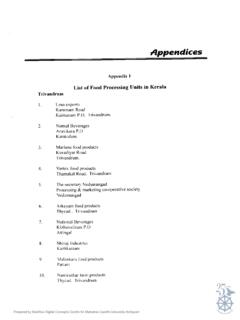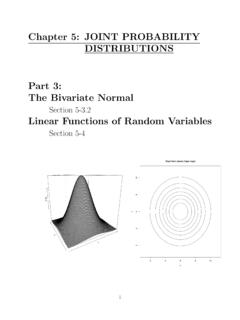Transcription of CHAPTER II REVIEW OF RELATED LITERATURE - Shodhganga
1 CHAPTER II REVIEW OF RELATED LITERATURE : Onifade (1983) examined the relationship among attitude, physical activity like adjustment and aggression and physical activity belief of Nigerian male (N=217) and female (N=133) University students is Attitudes were assessed through the attitude towards physical Activity inventory developed by Kenyon (1968), While physical activity behaviour was assumed by the use of a scale developed by Zoich Kowsky (1979). Data was collected on the physical activity belief of subjects by a scale development by the researcher. Data was analyzed through the use of univariate and multivariate statistical procedures. Results depicted that there was no relationship among attitudes, physical activity behaviour and physical activity belief of subjects. However, there were some relationship between some specific attitudes and physical activity behaviour and physical activity belief.
2 Subjects also chose individual physical activities and dual and team activities. Meeriman (1985) determined the relationship of the influence of social systems, attitude toward physical activity and physical education placement to the degree of participation in physical activity of emotionally disturbed high school students. 206 emotion of adjestment disturbed male and female students aged 14-21 attending public schools in New York City served as subjects. The degree of participation was measured by the Physical Activity Socialization Inventory. Attitude toward physical activity was measured by the Children s Physical Attitude toward Physical Activity Inventory. The analysis of data revealed that (1) the influence of social system was RELATED to the degree of participation. (2) The attitude toward physical activity was RELATED to the degree of participation.
3 (3) The influence of social systems and attitude toward physical activity, in combination contributed to variance in participation. (4) Attitude toward physical activity and physical education placement in combination contributed to variance in participation. (5) The influence of social systems, attitude toward physical activity and physical education placement, in combination contributed to variance in participation and (6) the total variance of participation occurred for the three predictor variables, the influence of social system makes the largest unique contribution. Hayajneh (1989) investigated sixty five Americans and Sixty seven Jordanians RELATED to aggression emotion both samples consisted of male and female sport participants and sport drop outs between the age of 11 and 17 years. He had two purposes. The first purpose was to determine any differences between Americans and Jordanians in their reasons for participating in and dropping out of youth sport programmers.
4 The second purpose was to examine factors in achievement motives that might discriminate from Americans extrinsic/intrinsic motivation and achievement goals. The most important reasons that Americans had for sports participation were liking to have fun, liking to improve skills and liking to learn new skills. For Jordanians liking the team spirit, liking to be popular and liking to travel were the most important reasons for participation. Both American and Jordanian drop outs listed emphasis on winning and losing and the lack of fun as a most important reason for dropping out of sports programmes. There were no significant differences between Americans and Jordanians in their factors of achievement motivation and sports participation. Almarif (1982) investigated personal motives and sociological factors which were socio-economic status, sports facilities availability, significant others participation in sports, significant others approval for participating in sports, birth order and factors influencing selection of sports.
5 His subjects were 600 male and female Iraqi athletes, between the ages of twelve and twenty-five. The results showed that male athletes tended to come from lower socio-economic families, whereas female athletes tended to come from upper middle and higher socio-economic families. Both males and females tended to rate some of the personal motives similarly but sport group differences were found on many personal motives for the sports participation and the results are as follows : (1) No significant differences were found between the mean scores of the male sport groups concerning two personal motives namely competence and fitness, health, (2) Significant differences were found between the female sports groups on all the ten personal motives, No significant differences were found between the mean scores of male and female volleyball athletes on seven personal motives namely, competent, social, athletic, compete/ challenge, potent and prestige.
6 (4) No significant differs were found between the male and female basketball athletes on all the personal motives except on the potent motive where the males scored higher than females. (5) No significant differences were found between the male and female table-tennis athletes on all the personal motives except on athletic and winner/prestige. Bhullar (1982) in the year 1982 under took a study entitled A Comparative study of attitude towards physical activity of university male and female students . The purpose of this evaluation was to discover the structure of attitude towards physical activity of male and female students living in the same environment. Subjects for this study included both male and female students. The 200 (100 male & 100 female) subjects who participate were drawn randomly from various teaching departments of the Punjab University campus, Chandigarh.
7 Their age ranged from 16 to 23 years. To measure attitudes, physical activity attitude scale constructed and standardized by the author was used which consisted of 70 items. Scoring was done on the basis of Scale Product Technique by giving weight for each response category in the Likert fashion and then multiplying the same with scale value of the statement. Dabas (1982) surveyed the facilities and equipments of sports and physical education in engineering colleges and concluded that the student teacher ratio in physical education was satisfactory and only one college had provided special coaching personnel for different games and sports. Out of five engineering colleges and three colleges had sufficient playground facilities as per minimum norms laid down by National plan of Physical Education and Recreation. The study revealed that all the engineering colleges did not possess sufficient number of equipment and playgrounds as per this student s strength.
8 Young (1969) studied the relationship between the personal, social adjustment, physical fitness and attitude towards physical education among high school girls with varying socio-economic levels. She concluded that there was no significant difference between socio-economic status groups with reference to physical fitness or attitude towards physical education. There was significant positive correlation between physical fitness and attitudes towards physical education for the entire population at .001level, within the high and low socio-economic groups at the .05 level and within the middle group at the .01 level. There was a significant correlation at .05 level but physical fitness and personal social adjustment for the population and within the low socio-economic status groups; there was an inverse and significant correlation between social adjustment and attitudes towards physical education at.
9 01 level. Sham (1987) undertook a case study to determine student attitudes towards varsity interscholastic sports participation and factors that affect their attitudes. Data was gathered from high school yearbooks. Pennsylvania Department of Education, a survey questionnaire administered to 155 high school student and individual interviews of selected students participants, student non-participants and community members. Results indicated: (1) level of sports participation remained approximately 25 percent over the period of 165-85. (2) Several factors appear to affect the attitudes of students toward participation in interscholastic sports. Parental influence was the most definite factor. Other factors noted were peer influence and coach influence, perceived athletic ability sport as fun, priority of sports and the relationship of sports to academic achievement.
10 (3) Students especially participants reacted favorably to the schools interscholastic sports programmed and believed that sports were worthwhile because they thought such concepts as cooperation, competition and learning responsibility. Sports were perceived as beneficial for physical fitness and adjustment. Students reacted negatively to the overemphasis on competition and winning pressure from coaches and sports not being fun. (4) Coaches, faculty, parents and community members believed that sports participation was beneficial to students. Malumpy (1970) used the Cattle 16PF to compare the personality traits of 120 woman 77 athletes and 43 non-athletes. In a further study, Malumpy found that athletes who played individual sports were more extrovert than who played team sports. Singer (1969) administered the Edward present performance schedule (EPPS) to base ball and tennis players and a group of non athletes.
